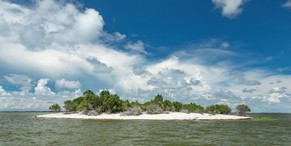
Research Spotlight: Factors Limiting Reproductive Success of American Oystercatchers in Florida's Southern Big Bend Region
Each breeding season, shorebirds and seabirds face numerous challenges on the road to reproductive success. At any site, there may be confounding threats to nesting birds that require a concerted effort to improve nesting outcomes. The 2022 Annual Report highlighted one such effort to improve shorebird productivity at the Barge Canal spoil islands in the Margorie Harris Carr Cross Florida Greenway State Park. The site is home to one of the largest concentrations of nesting American oystercatchers in Florida. Land managers successfully implemented a site-specific adaptive management plan to increase fledgling rates in an area to benefit nesting oystercatchers. The management actions were informed by the long-term data in the Florida Shorebird Database and the results of a study recently published in the Journal Waterbirds that intensively looked at factors limiting breeding success and.
The Florida Fish and Wildlife Conservation Commission (FWC) has monitored breeding oystercatchers in the Big Bend region since 2011. Continuous monitoring revealed that the Barge Canal spoil islands had high reproductive effort but consistently poor productivity. American oystercatchers exhibit high site fidelity and often continue to use the same nesting area for many years even when reproductive success is poor. In Florida’s Big Bend, where nesting habitat is limited, effective site management is critical for conserving this species.
Due to the remote nature of the spoil islands and rocky habitats, most nest and chick failures were attributed to unknown sources. To improve breeding outcomes, starting in 2016, the FWC and the University of Florida evaluated factors limiting breeding success at the Barge Canal spoil islands. The study used several techniques to monitor oystercatcher breeding activity including the use of game cameras, increased survey frequency, habitat surveys and human disturbance surveys.
Researchers used motion-sensing cameras to monitor oystercatcher nests and determine sources of failure or confirm successful hatching. The cameras also detected predators, chick presence, and humans on the islands throughout the breeding season. During the study, the use of remote cameras improved detection of nest failures. Results revealed that predation was the leading known cause of nest failure (31%) at the spoil islands. The data also showed that most documented nests survived to hatch, however, chick survival was low and 40% of the few chicks that survived to fledging did not survive until 60 days of age.
Through remote cameras and direct monitoring, the research revealed that numerous predators were attracted to the woody vegetation located on a few of the spoil islands. The presence of this vegetation attracted predators to oystercatcher nesting areas during critical times of the nesting season. The research led to the development of a management strategy to conduct vegetation management to reduce predator densities at the spoil islands. These activities resulted in incredible nesting outcomes at the site.
|